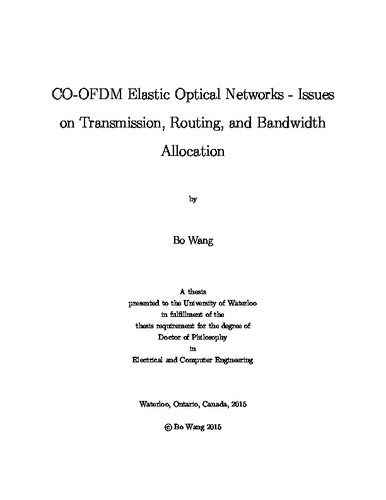| dc.contributor.author | Wang, Bo | |
| dc.date.accessioned | 2015-10-30 19:42:00 (GMT) | |
| dc.date.issued | 2015-10-30 | |
| dc.date.submitted | 2015 | |
| dc.identifier.uri | http://hdl.handle.net/10012/9851 | |
| dc.description.abstract | The use of orthogonal frequency division multiplexing (OFDM) technology helps an optical transmission system to break the limitation of wavelength grids by wavelength division multiplexing (WDM), in which a flexible and elastic transmission paradigm is created, so as to achieve better energy and spectrum efficiency and flexibility of the fiber resource. By jointly considering the nonlinear effect of Mach-Zehnder modulator (MZM) and amplified spontaneous emission (ASE) noise, we first provide an analytical model on the bit error rate (BER) performance for a single elastic optical transmission line. A novel adaptive transmission strategy in OFDM-based elastic optical transmission systems is proposed. Based on the adaptive transmission strategy, an optimization problem is formulated and solved via mathematical programming. By using proposed adaptive transmission strategy, the routing and bandwidth allocation (RBA) problem is formulated in elastic optical networks and numerically solved to route a set of lightpaths into a network according to the static or dynamic traffic demands with the best energy efficiency, where the laser transmit power, modulation level, number of subcarriers, and routing path of each node pair, are jointly determined. Case studies via extensive numerical experiments are conducted to verify the proposed strategy and gain better understanding on the solutions of formulated optimization problem. By further extending proposed adaptive transmission strategy, we propose a novel adaptive radio-over-fiber (RoF) transmission system for next-generation cloud radio access network (C-RAN). By considering nonlinear distortion from both MZM and high power amplifier (HPA), a 2 x 2 MIMO-OFDM baseband model for simulating the required ESNR of end-to-end RoF transmission system is developed. The RoF system for current C-RAN and proposed RoF system for future C-RAN are presented. We also propose a model to analyze the power consumption for the optical part of RoF transmission system. By performing case studies, proposed RoF system is demonstrated to be more energy efficient than current RoF system. | en |
| dc.language.iso | en | en |
| dc.publisher | University of Waterloo | |
| dc.subject | Elastic Optical Networks | en |
| dc.subject | Radio-over-Fiber | en |
| dc.subject | CO-OFDM | en |
| dc.subject | Energy Efficiency | en |
| dc.subject | Adaptive Transmission | en |
| dc.subject | Routing and Bandwidth Allocation | en |
| dc.title | CO-OFDM Elastic Optical Networks - Issues on Transmission, Routing, and Bandwidth Allocation | en |
| dc.type | Doctoral Thesis | en |
| dc.pending | false | |
| dc.subject.program | Electrical and Computer Engineering | en |
| dc.description.embargoterms | 4 months | en |
| dc.date.embargountil | 2016-02-27T19:42:00Z | |
| uws-etd.degree.department | Electrical and Computer Engineering | en |
| uws-etd.degree | Doctor of Philosophy | en |
| uws.typeOfResource | Text | en |
| uws.peerReviewStatus | Unreviewed | en |
| uws.scholarLevel | Graduate | en |

